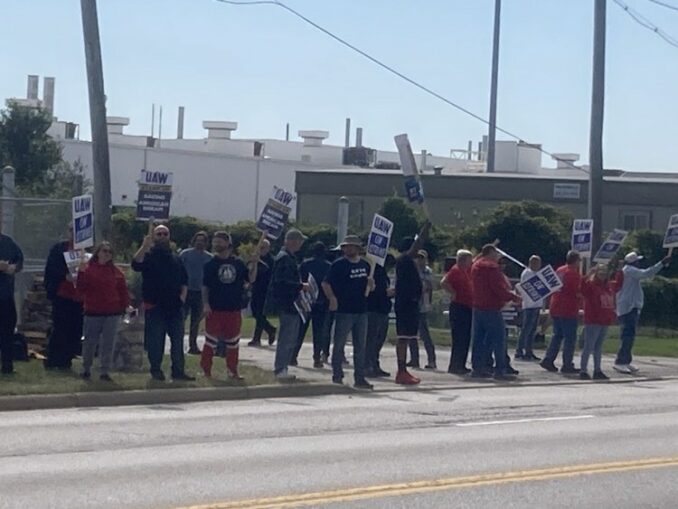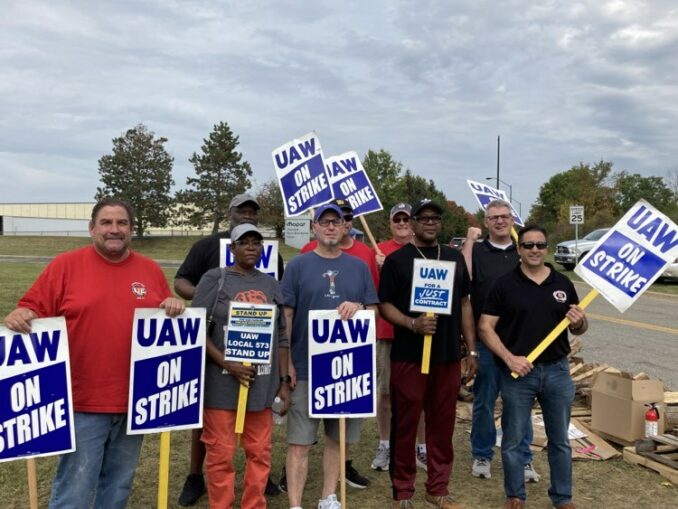Auto strike forces companies to ‘pony up’
The historic strike at Ford, General Motors and Stellantis (parent company of Jeep, Ram and Chrysler brands), which commenced Sept. 15, has ended at all three companies. The United Auto Workers union announced Oct. 25 that it had a tentative agreement with Ford. “We told Ford to pony up, and they did,” said UAW President Shawn Fain in a video message to union members. (uaw.org)

Day one of UAW strike, Toledo, Ohio, Jeep plant, Sept. 15, 2023. (WW Photo: Martha Grevatt)
On Oct. 28 the union reached a similar agreement with Stellantis, followed by GM on Oct. 30. To apply greater pressure on the last company, the same night the Stellantis deal was announced, the UAW expanded its targeted strike to GM’s plant in Spring Hill, Tennessee.
The actual Ford contract language was posted online Oct. 29.
There are big wins in this contract, which is far better than what the union could have won without a strike. All Ford workers will receive at least a 25% raise, plus the cost-of-living allowance formula, “suspended” during the 2009 GM and Chrysler bankruptcies, has been restored. Workers at certain Ford facilities, who currently make less than those at other plants, will now be paid the same hourly rate as their counterparts.
The time it takes to reach the top of the pay scale has been dropped from eight years to three and workers now classified as “temporary” or “supplemental” will be made permanent. Some lower-paid workers will see a pay increase of as much as 150%.
Other gains include pension improvements, Juneteenth as a paid holiday, two weeks paid parental leave, the right to strike over plant closings, the right to refuse to cross picket lines and the reopening of the closed Stellantis assembly plant in Belvidere, Illinois. There are no contract concessions, which were often agreed to by the previous, class-collaborationist leadership of the UAW.
Fight against tiers not over
One of the most destructive contract concessions was the two-tier pay structure, agreed to in the 2007 contract and expanded under the contract modifications during the 2009 bankruptcies. Workers hired after October 2007 were paid substantially less and had fewer benefits than those hired before them. They did not get a pension or health insurance when they retired.

UAW strike, Streetsboro, Ohio, Jeep plant, Oct. 5, 2023. (WW Photo: Martha Grevatt)
Two-tier was first peddled by then-President Ron Gettelfinger and continued under subsequent leaders on the International Executive Board, all members of the self-titled Administration Caucus. After Chrysler workers voted down a proposed contract in 2015, rejecting tiers, they approved a second contract that gave second tier workers the same pay as first tier workers — but it took eight years or more to get to the top! Now the time is down to three years for current and future workers, what it was before October 2007.
The contract makes progress in addressing the potential of “EV tiers” if the new electric vehicle battery plants are not brought under the master UAW contract. Before the strike all three companies were saying these plants were part of separate companies, joint ventures between one of the Detroit auto companies and a third party such as LG or Panasonic.
During the strike GM agreed to bring its Ultium battery plant into the master contract. Ford has agreed to bring its battery plants under construction into the master contract if the workers approve UAW representation via a card check.
Fain and six other members of the Members United slate ran against Administrative Caucus candidates, winning every spot they ran for on the International Executive Board. One of the primary campaign planks, which was later a strike slogan, was “end tiers.”
Unfortunately, while the new tentative agreement makes great strides against “wage tiers” it has not eliminated “retirement tiers.” Many workers with fewer than 16 years seniority cannot afford to retire because they would lose their health insurance.
The fight must continue until all tiers in the auto contracts are eradicated completely.
Time for a shorter work week!
Another concession from 2009 was the loss of overtime pay after eight hours in a day. Ford can still work people over eight hours at straight time pay under grueling “alternate work schedules.”
A key contract demand that the union did not win this time around was a shorter work week — 40 hours pay for 32 hours work, or one paid day off per week. The UAW had not brought this up since the 1970s, when it won one paid day off per month, a move that created thousands of jobs. The last union to call for a 32-hour work week may have been the Professional Air Traffic Controllers Organization, a union crushed by then-President Ronald Reagan.
Through automation, workers’ productivity has risen exponentially over the past few decades, with each new wave of corporate restructuring slashing thousands of autoworker jobs. Now the transition to electric vehicles (EVs) which require fewer components and thus fewer hours of labor, could eliminate 30% more jobs in the Big Three. A shorter work week is needed to offset potential job losses.
Even if the 32-hour week is not in these contracts, restarting the conversation after decades of neglecting the demand was a major contribution by the new UAW leadership.
Over the next few weeks, rank-and-file UAW members will attend informational meetings, after which they will decide whether to accept these contracts or go back on strike and fight for more.
The contracts are set to expire on May 1, 2028. Fain let the members know that the next auto strike, if one is called, would be on International Workers Day – May Day.
Seeing the UAW return to internationalism and class struggle unionism after decades of concession bargaining is a breath of fresh air. Now it’s time for the new breed of militant labor leaders like Fain, Sara Nelson (Association of Flight Attendants) and Sean O’Brien (Teamsters) to proclaim solidarity with the people and unions of Palestine.
Martha Grevatt is a retired UAW Stellantis worker.

